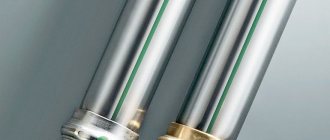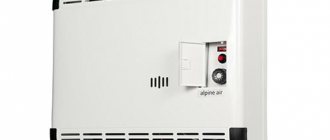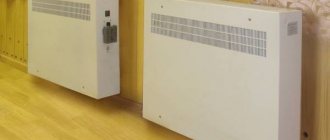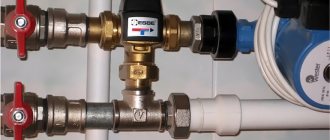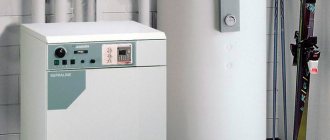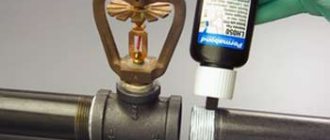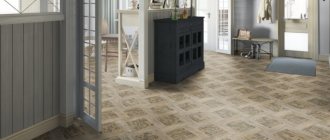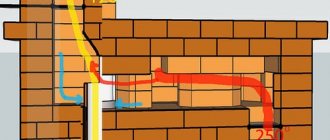Ecology of consumption. Estate: Heat loss is a serious problem that construction science is struggling with. Effective insulation, sealed windows and doors only partially solve this problem. Heat leakage through walls, windows, roofs and floors can be significantly reduced. Despite this, energy still has one more wide path to “escape.” This is ventilation, which is impossible to do without in any building.
Heat loss is a serious problem that construction science is struggling with. Effective insulation, sealed windows and doors only partially solve this problem. Heat leakage through walls, windows, roofs and floors can be significantly reduced. Despite this, energy still has one more wide path to “escape.” This is ventilation, which is impossible to do without in any building.
It turns out that in winter we spend precious fuel on heating rooms and at the same time continuously throw heat out into the street, letting in cold air.
The problem of energy saving can be solved using a heat recuperator. In this device, warm indoor air heats outdoor air. This achieves considerable savings on heating costs (up to 25% of the total cost).
In the summer, when it is hot outside and the air conditioner is running in the house, the recuperator also brings benefits. It cools the hot incoming stream, reducing air conditioning costs.
Let's take a closer look at household heat recovery units to have an idea of their structure, advantages and features of choice.
Tools and materials
An approximate set of materials and tools:
- metal 0.5-1 mm, textolite or cellular polycarbonate 1-5 mm in quantities of 5, 10 or 15 m2 depending on the type of recuperator;
- slats 2-3 mm made of wood, technical cork or plexiglass, 1-1.5 cm wide;
- stainless steel, chipboard, plywood for the body according to the drawings;
- mineral wool, polystyrene foam for thermal insulation;
- 4 plastic flanges for air ducts based on sewer pipes;
- jigsaws for wood and metal, preferably electric;
- silicone sealant;
- aluminum tube 2-5 mm, length according to the project;
- universal glue;
- self-tapping screws;
- steel corner 20x20 mm, length according to the project;
- screwdriver, hacksaw;
- paper filters, automobile filters - as many as needed;
- construction knife;
- hammer;
- drill, set of drills;
- computer or duct fans depending on the project.
Filters are replaced or cleaned every 1-4 months.
HEPA filters are recommended. They are inexpensive, yet perform very deep air purification; they are available in different sizes.
We prepare materials according to the selected type of recuperator.
What are they?
Units are divided into the following types:
- By type of design - shell and tube, spiral, rotary, plate, plate finned.
- By purpose - air, gas, liquid. By air we mean a ventilation unit whose task is ventilation with heat recovery. Gas-type appliances use smoke as a coolant. Liquid recuperators - spiral and battery - are often installed in swimming pools.
- According to the coolant temperature – high-temperature, medium-temperature, low-temperature. High-temperature heat exchangers are those whose coolants reach 6000 C and above. Medium temperature devices are devices with coolant characteristics in the region of 300-6000C. The coolant temperature of the low-temperature unit is below 3000C.
- According to the method of media movement - direct-flow, counter-flow, cross-flow. They vary depending on the air flow direction pattern. In cross-flow units, the flows follow perpendicular to each other, in counter-flow units, the inflow and exhaust are opposite to each other, and in direct-flow units, the flows are unidirectional and parallel.
Shell and tube heat exchangers
They have the simplest device. Disadvantages - weight, dimensions, difficulty in maintenance.
Spiral
In spiral models, heat exchangers look like two spiral-shaped channels through which media move. Made from roll material, they are wound around a dividing partition located in the center.
Rotary recuperators
Installed in supply and exhaust ventilation systems. Their method of operation is based on the passage of supply and exhaust flows through a special rotary heat exchanger of a rotating type.
Plate heat exchanger
It is a recuperator where heat is transferred from a hot medium to a cold one by passing through steel, graphite, titanium and copper plates.
Finned plate recuperator
Its design is based on thin-walled panels with a ribbed surface, produced using high-frequency welding and connected to each other in turn with a rotation of 900. This design, as well as the variety of materials used, makes it possible to achieve a high temperature of the heating medium, minimal resistance, long service life, high indicators of the heat transferring area in relation to the total mass of the heat exchanger. In addition, such devices are inexpensive and are most often used to process heat from waste gaseous media.
The popularity of finned models is based on the following advantages (in comparison with analogs of the rotary and traditionally plastic type):
- high operating temperatures (up to 12500C);
- small weight and dimensions;
- more budget friendly;
- quick payback;
- low resistance along gas-air paths;
- resistance to slagging;
- ease of cleaning channels from contaminants;
- long service life;
- simplified installation and transportation;
- high thermoplasticity rates.
Industrial and household heat exchangers - what are the differences?
Industrial units are used in industries where thermal technological processes are present. Most often, industrial heat exchangers mean traditional plate heat exchangers.
Household installations include devices characterized by small dimensions and low performance. These can be supply and exhaust models, the main task of which is ventilation with heat recovery. Such systems can be implemented in different ways - both in the form of a rotary and in the form of a plate heat exchanger. Moreover, each of them has its own advantages and disadvantages.
Next, we will consider the main selection criteria to understand which recuperator is better to buy.
How to increase efficiency
To increase the efficiency of a home-made device, technological operations should be carefully performed at all stages of its design and manufacture.
Efficiency is the proportion of energy that warm air transfers to cold air during heat exchange. Therefore, this share should be maximized:
- increase the dimensions of the device - the time of interaction of air flows increases, and hence the heat exchange;
- increase the working surface area of the recuperator using corrugated plates with smaller profile sizes;
- design larger volumes of exhaust air than incoming air;
- good quality heat-insulating materials
- carefully seal all volumes with moving air, avoiding mixing of flows;
- clean or replace input/output filters in a timely manner , thereby reducing resistance to air flow and improving its quality;
- turn off the input fan from time to time in winter to remove ice from inside the device.
After installing the recuperator in its operating position, it is reasonable and interesting to find out its efficiency. This value gives the ratio of the share of energy transferred to cold air from warm domestic air.
The order is:
- turn on the device, wait a while;
- We measure three temperatures with a thermometer - from the street at the entrance of the device, in the house, at the exit;
- calculated using the formula efficiency = (Tr-Tu) / (Td-Tu) * 100, where
- Тр – temperature at the recuperator outlet;
- Tu – temperature at the entrance, from the street;
- Тд – house temperature.
Example: Tr=17, Tu=5, Td=24 degrees. Efficiency = (17-5) / (24-5) *100=63%.
Getting to know the equipment
The unfamiliar word “recuperator” comes from the Latin “recuperatio”, which means “return”. In our case, this is part of the warmth in winter or coolness in summer. The rotary recuperator, like its plate “colleague,” performs heat exchange: it transfers heat from the exhaust exhaust air to the cold supply air. Or, on the contrary, it takes away some of the heat from the incoming heat, mixing it with the comfortable cool outgoing masses. The result of its regenerative winter “activity” is a reduction in the cost of electricity spent on space heating.
Device
All devices differ in design and are designed to perform their tasks, which differ to a greater extent in scale. If we compare two popular types of devices - rotary and plate heat exchangers, then the latter is intended for small rooms. The first, the hero of this article, is able to cope with a more serious task - making a room of a sufficiently large area comfortable.
The heat exchanger in question consists of a galvanized steel (aluminum for small models) housing, a belt drive and a rotor. The basis of the device is a drum rotated by a motor. This cylinder is made of two types of aluminum foil: smooth and corrugated (60-120 microns). They are wrapped around each other. The rotor structure includes axial bearings, a sensor to control rotor rotation, and a sealing tape that isolates air flows.
Inside the drum there are channels - coaxial and triangular. It is installed perpendicular to the movement of air masses. The outgoing air leaves heat in the sector of the rotor through which it passes. Rotating, the device transfers thermal energy to the inflow masses, and the heated sector itself is cooled.
Characteristics
The efficiency of rotary recuperators is 70-85% (87%). In addition to retaining heat, the devices do another job: they transfer moisture. For rooms where the humidity level is constantly increased (or decreased), such additional equipment is the best option.
It is technically impossible to completely isolate outgoing and incoming flows from each other. But such a task is not set, because only about 5% is mixed, or this figure is slightly higher. It is possible to change the rotation speed of the heat exchanger: frequency converters are used to adjust productivity.
Rotor designs are more efficient than their vane counterparts, but due to the complexity of the design and higher efficiency, they are not cheap. However, due to its high efficiency, the equipment pays for itself in 1-2 years. It is installed as an additional element of the ventilation system in medium-sized premises: garages, offices, private houses, and small warehouses.
Design and principle of operation of the equipment
During removal, waste streams pass through a heat exchanger, giving off heat. This is the basic principle of operation. The recuperator consists of a housing to which pipes are connected, fans, filters and heat exchange cassettes are mounted.
- The air is collected through ducts;
- With the help of a fan it is supplied to the system;
- Passed through a recuperator;
- Released into the atmosphere;
- Fresh streams are taken from the street and passed through the recuperator again;
- Partial heat is taken away and transferred to the incoming inflow.
Rotary
Works using a rotating element. The drum is made of aluminum foil with high heat conductivity. When removed, heat is transferred to incoming air masses.
The device is not susceptible to frost. There is less dryness in the rooms. The rotary heat recuperator for ventilation air consumes electricity economically. The required number of rotor revolutions is set. Using the rotation speed controller, the thermal output power is changed. Operating efficiency: 87%
The principle of operation of a recuperator using a simple example
Unlike other modern “active” ventilation systems, the recuperator design does not imply the presence of a built-in air heater. This device uses the principle of recovering heat, taking it from the air removed from the room. For this purpose, the recuperator design includes a heat exchanger.
The easiest way to explain the recovery process is by analogy with a scarf that we use in winter, breathing through it. As you exhale, the scarf retains heat, and as you inhale, it transfers it to the frosty air: it enters our lungs already warmed up.
A recuperator for a private house, apartment or cottage works on the same principle: a fan “blows” warm exhaust air from the room to the street, while its heat is retained in the heat exchanger. After a minute, the fan turns on in reverse and an “inhalation” occurs—a new portion of fresh air is drawn into the device. When passing through the heat exchanger, it heats up and enters the room already warm.
Air recovery is the most natural, simple and economical solution to the problem of heat conservation when operating a ventilation system.
Recuperator efficiency
The most important characteristic of a recuperator is its efficiency. It shows how much the recuperator was able to heat the supply air relative to the ideal option. The ideal option is taken to be the case when the supply air is heated to the temperature of the exhaust air. In practice, this option is unattainable, and heating occurs to a certain intermediate temperature Tp. The efficiency formula is as follows: K= (T_P-T_N)/(T_B-T_N), where:
- TP – supply air temperature after the recuperator, °C,
- ТН – outside air temperature (supply air to the recuperator), °С,
- TV – temperature of the exhaust air to the recuperator, °C.
This formula takes into account the change in sensible heat in air flows. However, the relative humidity of the flows may also change, and then it is better to resort to calculating the efficiency of the recuperator based on the total heat. The formula is similar in appearance to the previous one, but is based on the enthalpies of air flows: K = (I_П-I_Н)/(I_В-I_Н), where:
- IP – enthalpy of supply air after the recuperator, °C,
- IN – enthalpy of outside air (supply air to the recuperator), °C,
- IB – enthalpy of exhaust air to the recuperator, °C.
The first formula allows you to quickly assess the efficiency of recovery. For more accurate results, use the second formula.
Recuperator: is it necessary or not?
We have already discussed how to select an air recuperator and install it, but we haven’t talked about the main thing. Why is such a device needed? The main answer is to keep the windows open so there is fresh air in the house. This is convenient for large cities, since dust, car exhaust fumes and noise enter the room along with the air from the window. In this regard, a recuperator is a very useful thing, but what about the savings?
Let's face it, it's a bit exaggerated. Let's look at everything realistically, the declared efficiency, for example, 55%, reduces heat loss through air exchange by half. Losses through walls and ceilings do not count, since the recuperator does not affect them in any way. Let's say the air exchange is 200 cubic meters per hour - this is according to SNIP for a house of 70 square meters. To heat such a volume of air, you will need about 10 kW of thermal energy, which is 1.05 cubic meters of gas. Saving 50% will save 0.5 cubic meters of gas per hour. A cubic meter of gas in Moscow costs 6 rubles, which means the recuperator saves 3 rubles per hour, which is 72 rubles ($1) per day.
The cost of a decent recuperator that will actually work starts from 1 thousand dollars - this is the simplest and cheapest, and up to 3 thousand dollars. If you save $1 a day, the device will pay for itself in 3 years, and if a more expensive device, then in 8 years. At the same time, we did not calculate the energy costs for the fans, although it’s a small thing, it also costs money. In the end, is it worth investing from 1 to 3 thousand dollars in order to recoup your money in 3-8 years? It's probably easier to pay for gas.
Advantages and disadvantages of different types of recuperators
The advantage of recuperators is obvious - they allow you to significantly save on heating the supply air in winter and cooling the supply air in the summer. Among the disadvantages of recuperators are the following:
- They create additional aerodynamic resistance in the network. Indeed, like any other element in the ventilation network, recuperators have some resistance, which should be taken into account when choosing a fan. However, this resistance is not high (usually no more than 100 Pa), and does not lead to a significant increase in fan power.
- Recuperators increase both the cost of the ventilation unit and the cost of its maintenance. Like any other solution aimed at increasing the energy efficiency of the system, recuperators cost some money and require regular maintenance. However, experience has repeatedly proven that the costs of heat recovery are much lower than the benefits obtained.
- Rotary, chamber and, to a much lesser extent, plate heat exchangers have one drawback, which can be critical at some facilities - leakage of air flows is possible in them. In this case, the danger is the flow of exhaust air into the supply air. Such leaks are undesirable in clean room ventilation systems and are not acceptable, for example, in infectious diseases departments of hospitals and operating rooms. The reason is the danger of viruses that have entered the hood from any room flowing into the supply air flow with subsequent spread throughout all rooms of the facility. As a result, recuperators with intermediate coolant or freon recuperators are used at such facilities.
- Recuperators increase the dimensions of the ventilation unit. This primarily applies to plate recuperators, since they are air-to-air heat exchangers and are quite large in size. In addition, this applies to recuperators with intermediate coolant due to the presence of two separate heat exchangers, two pipeline lines and piping units near each of the heat exchangers.
Review of the VAKIO recuperator
Ventilators using the recovery principle have recently appeared on the Russian market and are represented by a small number of models. One of the most popular is the wall-mounted recuperator VAKIO, produced by a Russian manufacturing company. Unlike many breathers, this device can operate in 3 modes.
- Exhaust mode (when it is necessary to remove smoke or odors from the kitchen from the room);
- Inflow mode;
- Supply-exhaust mode (the main operating mode of the recuperator, in which air exchange is carried out with minimal energy consumption).
Inflow mode
Fresh air is heated from the heat exchanger and enters the room
Exhaust mode
Polluted air is removed from the room and heats the heat exchanger
Recuperator efficiency . VAKIO is able to provide clean, fresh air to a room with an area of up to 30 sq.m. Working as a regular “supply” it supplies up to 120 m³ of air per hour, in the “supply-exhaust” mode the productivity is 60 m³ per hour.
Electricity consumption . No more than 18 watts per hour.
Tests have shown that when the external temperature is -20°C and the room temperature is +23°C, then the average temperature of the supplied air in recovery mode is +15°C. At the same time, the device consumes only from 5 W to 18 W and simultaneously solves two problems: it supplies heated and clean air to the room, and reduces heating costs.
Cleaning class . In addition to air exchange, the purpose of the recuperator also includes removing various contaminants from the air. For this purpose, the design of the device includes a filter system that provides medical grade cleaning.
Installation .
Vakio is installed in a hole in the wall. A fan and heat exchanger are located inside the channel. Installing the device usually takes about 1 hour and will not harm the renovation of the room.
Which one to choose for an apartment or a house?
The consideration of the types of existing recuperators can be continued further by talking about the types of ribbed plate recuperators, etc. But the issue of independent production of such a design and its practical application in one’s own house or apartment is of interest. First of all, you need to think about the required type of heat exchange unit. If all the windows in the apartment are plastic and effective ventilation is required, it is better to give preference to the ready-made industrial compact assembly DRTVV (“warm window”).
The recuperator will provide good ventilation in the room
For private households, where the issue of free space is not so acute, one of the cross-flow or counterflow plate designs is quite suitable. They are the easiest to make yourself. Below we consider the simplest way to independently manufacture a plate-type heat exchanger itself. Circuit solutions for automatic control, a damper device for switching to the bypass channel, etc. can be found on the corresponding Internet resources or in specialized literature.
Types of rotary recuperators
Models differ in the coating of the rotary drum. Recuperators are:
- Hygroscopic (enthalpy). In these devices, the honeycomb of an aluminum drum is coated with a material that has sorbing (absorbing) properties. As the drum rotates, it collects moisture so it can transfer it from one stream to another. As a result, both condensate and latent heat of the air are utilized.
- Sorptive. This is a hygroscopic type, but with improved characteristics thanks to an innovative sorbent - silica gel. Its main property is its increased ability to absorb moisture.
- Condensation. These are the most common designs. The aluminum rotor is devoid of additional coating, so it transfers only thermal energy and is not able to completely move moisture.
- Epoxy coated. It is intended to protect the aluminum drum from chemical compounds in the air. For example, from the concentration of sea salt, chlorine in swimming pools, from vapors in chemical production.
- With antibacterial coating. It can stop about 600 types of microorganisms. Such protection is applied to enthalpy rotors and epoxy-coated drums.
In everyday life, ordinary condensation devices are usually used, hygroscopic ones - where there is constantly high humidity. Other types are purchased for premises with unfavorable (harmful) working conditions. Rotary recuperators differ in appearance and their design is different: they can be either vertical or horizontal.
Self-production of a recuperator
Today on sale you can find various models of factory-made air recovery systems for a private home, which are distinguished by their build quality, have high efficiency rates, and their installation is not difficult. However, the high price of such equipment negatively affects its popularity on the Russian market.
Therefore, many domestic homeowners make their own heaters, which can be made from scrap materials using simple tools. You just need to think about the type of design, and also calculate the power of the installation, which should match the performance indicators of the entire ventilation system in the house.
The easiest way to make your own is a plate-type recuperator for a private house, which is characterized by its simple design and efficiency. You can find numerous designs for such equipment, which greatly simplifies the work; at the same time, it is possible to accurately calculate the power of a particular installation.
The advantages of homemade plate recuperators include the following:
- Long service life.
- Simplicity of the materials and functional elements used.
- Reliability of the design.
- Full autonomy and no connection to the power supply.
- High efficiency.
We recommend that you read: Is it possible to use sewer pipes for ventilation?
The only disadvantage of such heaters for the ventilation system is the likelihood of ice formation during severe frosts, which negatively affects the efficiency of the installation, up to the complete cessation of heating the air coming from the street. To solve such icing problems, it is necessary to additionally insulate the recuperator or install it in a warm heated room.
Homemade cassette-type recuperators are very popular, they are effective and at the same time completely solve problems with condensation and icing at low temperatures. Such heaters and their cassettes can be made from cellulose, and the body of the device is made of tin or any other metal that is well protected from corrosion.
Required components and materials
Before directly starting to manufacture the recuperator, it is necessary to prepare the tools and materials used. For this work you will need the following:
- Computer fan.
- Four flanges.
- Corner.
- Hardware.
- Sealant.
- Glue.
- Plywood or metal for the body of the device.
- Mineral wool for insulation.
- Wooden slats for the base.
- Aluminum sheets for making cassettes.
You can use ready-made cellulose cassettes, which are produced for car filters and air conditioners. Their use makes it possible to significantly simplify the manufacture of a recuperator, increasing its power and subsequently simplifying the maintenance of home-made equipment.
Finding easy-to-implement schemes for making homemade recuperators on the Internet is not difficult. Also, the simplest drawings can be completed independently, taking into account the power of the equipment and the required productivity. You should not make such a device without a manufacturing diagram, since in the future it will be difficult to correctly assemble the entire system, which negatively affects the reliability of the equipment and its efficiency.
Heater assembly
Assembling the recuperator is not particularly difficult. It is necessary to cut at least 70 sheets of metal with side sizes from 200 to 300 mm. Wooden slats are prepared, the dimensions of which must completely correspond to the sides of the cut metal sheets. The wood should be treated with drying oil, which will prevent rotting and loss of strength of the internal elements of the heat exchanger. The prepared slats are glued with glue on both sides of the metal squares. Having collected all the blanks, you can proceed to the next stage of work.
The assembled squares should be alternated with a 90-degree rotation, which will ensure a perpendicular arrangement of the cassettes inside the recuperator, thereby guaranteeing maximum heating efficiency of the air flows without mixing them. The upper square, to which the slats are not attached, is glued to the lower one using special metal glue. Additionally, to increase the strength of the structure, it is tightened with corners and fixed with self-tapping screws or similar fasteners. The cracks should be treated with sealant, after which flange mounts are formed.
The heat exchanger of the supply heat exchanger is ready. All that remains is to make the body of the device from metal or lumber and mount a honeycomb cassette inside the frame. The heat exchanger must be installed in such a way that it rests against the ribs, visually forming a rhombus through which cold air from the street and the heated flow from the house will subsequently pass.
If the body of a homemade recuperator is made of wood , the lumber should be treated with special impregnations, which will prevent them from rotting and rapid failure of the equipment. During operation, condensation will form on the heat exchanger, which drains from the metal cassettes, accumulating at the bottom of the housing. Small holes should be provided to remove moisture, which are located flush with the bottom of the device body.
At the last stage of the work, four flanges are attached to the wooden or metal body, which are made of polypropylene pipes or similar materials. They are fixed using appropriate clamps and fittings, additionally coated with sealant to ensure the maximum possible tightness of the manufactured device body.
To increase the efficiency of a homemade ventilation recuperator, it should be additionally lined with mineral wool, which prevents heat loss and the formation of condensation. The latter often appears if such equipment is installed outdoors or in an unheated room.
At the entrance of the installation, you can install air filters that provide primary air purification from existing contaminants, poplar fluff and various allergens.
The use of a recuperator in the ventilation system of a private house allows you to expand the functionality of such equipment, preventing the rapid cooling of rooms in the winter, which saves the homeowner's expenses on utility bills. Owners can purchase ready-made heaters that are compact in size, easy to install and efficient. You can also make a recuperator yourself, which will reduce the cost of installing utilities in a private home.
What is an air recuperator
A recuperator (“return”, Latin) is a supply and exhaust unit that simultaneously performs two tasks - supplying fresh air and removing old, exhaust air. The device includes a heat exchanger that accumulates heat from warm air that is drawn from the room to the street. This heat is used to heat the air when the device begins to work on the influx of fresh cool air from the street, which makes it possible to save on heating.
The air coming from the street is heated without the use of electricity thanks to recuperation.
Classification of recuperators
The main differences between the devices lie in the principles of coolant movement, design features and purpose. Then the types of recuperators can be:
- Lamellar.
- Rotary.
- Water.
- Placed on rooftops.
Lamellar
The most popular type, due to its low price and decent efficiency, is a plate heat exchanger for air ventilation. The structure of the heat exchange unit in the middle of the device has the form of one or several copper, aluminum, plastic or solid cellulose plates fixed in a static state. The process of air movement through the cassettes occurs without mixing with simultaneous cooling or heating of the flows.
A distinctive feature of this type of recuperator is its compactness and reliability. The devices practically do not fail. Operation is carried out without the use of electricity and this is its big advantage. The main disadvantage of this type of device is its inoperability in severe frosts due to freezing of the hood and the impossibility of moisture exchange (freezing of condensate in the exhaust ducts).
Sample of a plate air recuperator Source vents-mag.com.ua
Rotary
The work is carried out by electricity, due to which the rotor blades (one or two) rotate and air flows move. Most often, a rotary air recuperator is cylindrical in shape with tightly installed plates and a drum in the middle. They rotate due to the movement of air, outgoing indoor and incoming outdoor. This type is distinguished by its large size, however, its productivity is significantly higher compared to plate-type ones. Therefore, purchasing this type of device for a private home is unprofitable; they are more suitable for large volumes, such as a hospital, restaurant, shopping center, concert hall. The main disadvantages are the high cost of maintenance, energy consumption, bulkiness, purchase cost, and the need for a ventilation chamber.
External view of a rotary heat exchanger Source mozfiles.com
Water
The principle of operation of a water recuperator is reduced to the transfer of heat energy to the heat exchange element through water or another liquid (antifreeze, etc.). The performance of this type of device is similar to plate heat exchangers, but operates on the principle of a water heating system. Weaknesses: low efficiency and the need for frequent maintenance.
Example of a liquid recuperator Source teploobmenik.ru
How to choose?
When choosing a household device, you should pay attention to the following parameters:
- Material;
- Functional;
- Room type;
- Productivity and microclimate conditions;
- Installation method.
Material
The heat exchanger can be:
- Ceramic. One of the advantages is that it effectively accumulates and releases heat for a long time, and is not afraid of moisture. And thanks to the structure in the form of a honeycomb, the area of the heat-conducting material is as wide as possible. The downside is that it takes a long time to heat up.
- Copper/aluminium. The material is inexpensive and conducts heat well. The exhaust air gives off thermal energy to the plates, which in turn heat the fresh supply air.
- Plastic. Plastic has been used quite recently, and therefore it is still difficult to get a complete picture of it. Experts call such devices experimental and so far note only the price as an advantage;
- cellulose Able to function in conditions of medium and low humidity, maintaining its optimal level. Pros: Doesn't dry out. Of the minuses: it is sensitive to moisture and low temperatures - it freezes at -50C.
Functional
Some models may have the following functions:
- Highly efficient multi-level filtration system;
- Heating of the supply flow;
- Step control of fan speed;
- Thermal energy recovery up to 94-97%;
- Control and monitoring of air quality using various sensors;
- Operation in “night” mode, protecting from noise;
- Work in automatic mode;
- Control via PC, smartphone, tablet, remote control.
Room type
Ventilation installation must be carried out taking into account air exchange standards, which differ depending on the type and purpose of the room. Thus, it is recommended to organize air flow for bedrooms and living rooms. And for bathrooms, lavatories and kitchens, equipment that produces hoods is best suited. This is necessary in order to prevent polluted air from moving into living rooms.
Offices are characterized by the problem of excessive heat generation from equipment and a large number of employees. In addition to the large amount of heat in gyms, due to the active interaction of visitors with exercise equipment, there is also high humidity. In both cases, a more powerful unit than for a home is required.
When installing equipment in school classrooms and rooms in kindergartens, it is necessary to take into account several important factors at the same time - the number of people, humidity and the volume of pollutants.
For a private home, wall-mounted plate units are most suitable. They are easy to install, do not require additional care or special maintenance, and do not spoil the interior. If you intend to install powerful equipment, which implies large dimensions of the device, then it is better to provide for installation during construction.
A plate model is also suitable for an apartment, but in order to avoid mistakes when choosing, you should take into account the fact that most of the heat exchangers, due to their impressive dimensions, are designed for thick external walls. And for an apartment you need a device that can withstand the wall in a panel house. A good option is a device using reverse technology.
It is also important to consider the area that the recuperator will have to service. It must match the power and throughput of the equipment. A device that is too powerful in a small area will be energy-consuming and uneconomical. And if it is not powerful enough in a large serviced area, it will not be effective enough and will not give the desired result.
Productivity and microclimate conditions
The flow rate of supply air in a residential area can be calculated in two ways - based on the area, and also based on the number of living (permanently present) people.
Microclimate conditions in living and sleeping rooms can be:
- increased optimal (36 m3/1 person or 5 m3/hour per 1 m2) – necessary for people with special needs, for example, the disabled, the sick, young children, the elderly;
- optimal (25 m3/1 person or 3.6 m3/hour per 1 m2) – creates a feeling of comfort due to the optimal ratio of freshness and warmth, helps to increase performance and activity;
- acceptable (15 m3/1 person or 2.2 m3/hour per 1 m2) – force a person to use additional thermoregulation mechanisms for physiological adaptation, but do not cause irreversible or dangerous health consequences.
The CO2 indicator is also important. Carbon dioxide (also known as carbon dioxide) is released by humans at approximately 20-25 liters per hour. When people are constantly indoors, the CO2 level increases, and the amount of organic matter and bacteria also increases. The latter is quite simply determined by the smell - the air becomes stuffy and heavy. When the CO2 concentration is above ten percent, a person loses consciousness.
At the same time, according to European regulations, optimal conditions are created when 12 to 25 m3 of fresh air per hour per person enters the room. Thus, the unit’s productivity of 120 m3/hour will be enough to satisfy the needs of 3-4 people in the room at the same time.
Installation method
Possible floor, suspended and roof.
Options with ceiling installation are interesting because they allow you to hide all the technical details in the cavity of suspended and suspended ceilings. The price of such devices is quite high and is determined by the requirements for the dimensions of the device - it must be compact. At the same time, auxiliary bypass channels are not required to connect it. A significant disadvantage of this method is noise during operation, which is caused by the small distance between the functioning parts and the ventilation grilles.
Floor and wall mounted devices are designed for placement in technical rooms. The performance of such models is not limited by dimensions, but it is important to correctly produce the strapping system. Floor/wall category devices are used in conjunction with air conditioning and heating systems.
Rooftop models are frequent guests in buildings with one large room. They are mounted on the roof of a building and have such advantages as a high level of efficiency, quick and simple installation, and easy maintenance.
There are also point wall models that are mounted separately in each room adjacent to the street. They are good because they do not require additional communications.
Briefly about the main thing
A recuperator is a device that allows you to provide a flow of fresh and clean air into a room without unnecessary energy consumption. In winter it prevents the loss of room heat, and in summer it prevents the penetration of hot air into the room.
This device has a number of advantages over a conventional ventilation system. However, when choosing a recuperator, it is important to take into account many factors - the required type of device, the size of the room being served, climate, humidity, etc. It is important to think in advance about the possibility of installing the device indoors, its cost, and performance. The efficiency of ventilation, and therefore the quality and comfort of life in the house, directly depends on all this.
Ratings 0
The best household recuperators
Considering that plate heat exchangers require the organization of a full-fledged ventilation duct, and not every private house has such an opportunity, it is recommended to install small rotary models for domestic needs.
Table 1. Budget models of household recuperators
| Image | Model | Case diameter, mm | Efficiency, % | Power consumption, W | Air volume, cubic meters | Average cost, rub |
| Prana-150 | 150 | 91 | 7-32 | 25-115 | 21000 | |
| Prana-200G | 200 | 88 | 7-32 | 25-135 | 22600 | |
| TeFO 1 | 110 | 75 | 3,6-36 | 35 | 13000 | |
| TeFO 3 | 125 | 75 | 52 | 91-100 | 23000 | |
| Clean air 16-K | 125 | 78 | 2-16 | 70 | 15900 | |
| Clean air 16-M | 150 | 80 | 2-24 | 120 | 17900 | |
| Mitsubishi Electric VL-100 UE | 168 | 77 | 26 | 105 | 18110 | |
| Vents TwinfreshRA-50 | 280 | 90 | 46 | 50 | 18540 |
Small household rotary air exchanger
Features of choosing a recuperator
Having become familiar with the operating features of recuperation units, it’s time to move on to the practical part – the selection criteria for performing specific tasks.
The first thing you need to pay attention to is the installation method. Domestic supply and exhaust ventilation with heat recovery can be installed in its working position in several ways:
- Inside the wall. The housing is mounted in a pre-drilled hole. A cap is placed on the outside, and a grille and control unit on the inside.
- Indoors. The installation is hung on the wall. A grille or cap is placed outside.
- Outdoor placement. The advantages of this solution are obvious: minimum noise and space saving. The duct design of the device allows it to be placed on balconies and loggias, as well as simply on the facade of a building.
Another parameter that needs to be taken into account when purchasing is the number of fans. Budget air recuperators for the home are equipped with one ventilation unit that operates for both supply and exhaust.
More expensive devices have 2 fans. One of them pumps in and the other exhausts air. The performance of such devices is higher than that of single-fan devices.
When purchasing, you should also pay attention to the presence of an electric heater. With its help, freezing of the cassette is prevented and the lower temperature limit of the device’s operation is increased.
Climate control function. Allows you to accurately set the temperature to which the recuperator will heat the air.
Possibility of humidity control. This parameter significantly affects the comfort of the microclimate. A standard recuperator dries the air, removing moisture from it.
Presence or absence of a filter. An additional option that has a positive effect on the sanitary characteristics of the air mixture.
An important parameter that requires attention is the temperature of the pumped air. In different models, its value may differ significantly. The widest possible range of operating temperatures from -40 to +50C is rare for household devices.
Therefore, in addition to taking into account the optimal performance in m3/hour, when purchasing, choose a device that can fully operate in your climatic conditions.
